Opportunities and Challenges for Research on Heat Recovery from Wastewater: Bibliometric and Strategic Analyses
Abstract
:1. Introduction
- Presentation of the results of the bibliometric analysis of publications in wastewater heat recovery domain (Section 3.1).
- Presentation of the latest research on the use of wastewater heat exchangers (Section 3.2.1) and wastewater heat pumps (Section 3.3.1), as well as WHRSs in industrial facilities (Section 3.4).
- Indication of strengths and weaknesses of wastewater heat exchangers (Section 3.2.2) and wastewater heat pumps (Section 3.3.2).
- Identification of potential opportunities and threats for the development of wastewater heat recovery technology based on the use of heat exchangers (Section 3.2.3) and heat pumps (Section 3.3.3).
- Discussion of the aspirations of wastewater heat recovery systems based on the use of heat exchangers (Section 3.2.4) and heat pumps (Section 3.3.4), as well as the results that are possible to achieve.
- Indication of examples of the use of WHRSs in practice (Section 3.5).
2. Materials and Methods
2.1. Bibliometric Analysis
2.2. SWOT and SOAR Analyses
3. Results and Discussion
3.1. Bibliometric Analysis
3.2. Heat Recovery in Residential and Commercial Buildings Using Wastewater Heat Exchangers
3.2.1. The Latest Research on the Use of Wastewater Heat Exchangers
3.2.2. Strengths and Weaknesses
3.2.3. Opportunities and Threats
3.2.4. Aspirations and Results
3.3. Heat Recovery from Wastewater Using Heat Pumps
3.3.1. The Latest Research on the Use of Wastewater Heat Pumps
| Authors | Aim of the Paper | Source Title |
|---|---|---|
| Zhang et al. [120] | Analysis of the operation of a domestic hot water installation based on the use of solar collectors and a wastewater heat pump using the TRNSYS | Energy (Elsevier) |
| Todorović et al. [124] | Demonstration of a domestic hot water preparation system in a hotel based on a heat pump, where the lower energy source is greywater and rainwater | Journal of Thermal Analysis and Calorimetry (Springer) |
| Pokhrel et al. [119] | Economic, technical, and environmental analysis of utilizing two methods to replace conventional heat sources for space heating and water heating, including wastewater heat pump, in two multi-family buildings | Energy and Buildings (Elsevier) |
| Qin and Tian [127] | Demonstration of a wastewater heat pump system with a plate heat exchanger and wastewater filter | Heat and Mass Transfer (Springer) |
| Kim et al. [118] | Experimental research of two types of HPs applied in block heating and cooling networks | Energies (MDPI) |
| Zhu et al. [128] | Investigation of the relationship between various parameters related to the application of a wastewater HP, such as flow rate and wastewater temperature, thermal power, and system location | Urban Water Journal (Taylor & Francis) |
| Ali and Gillich [121] | Demonstration of the potential of raw and treated wastewater as a source of heat for HPs in London, along with the political implications for the UK’s district heating strategy | Building Services Engineering Research & Technology (Sage Publications) |
| Fadnes et al. [129] | Presentation of a modern thermal energy plant consisting of wastewater heat pumps, a biogas boiler, thermal solar collectors, and greywater recycling, the concept of which was created as a result of cooperation between three partners: the industrial plant designer, the municipal plant owner, and the local academic institution | Frontiers in Energy Research (Frontiers Media) |
| Łokietek et al. [35] | Determining the potential of wastewater heat recovery in various sections of a wastewater treatment plant on the example of a facility located in Poland | Energies (MDPI) |
| Wang et al. [130] | Analysis of the feasibility of utilizing reclaimed water from a wastewater treatment plant as a lower energy source for a heat pump to provide heating buildings in a district heating network | Energy Technology (Wiley) |
3.3.2. Strengths and Weaknesses
3.3.3. Opportunities and Threats
3.3.4. Aspirations and Results
3.4. Heat Recovery in Industrial Facilities
3.5. Heat Recovery from Wastewater in Real Conditions
3.5.1. Examples of the Use of Wastewater Heat Recovery Technology
3.5.2. Evaluation of the Economic Aspects
4. Conclusions
- The greatest interest in research on wastewater heat recovery is observed in such countries as China, USA, Turkey, United Kingdom, and Sweden.
- The most influential journals in terms of number of publications are Energy and Buildings, Applied Thermal Engineering and Energies, while in terms of the average number of citations it is Energy Conversion and Management.
- The number of publications on wastewater heat recovery has been growing steadily since 2007. In recent years, it ranged from 30 to 50 items per year.
- The keywords referring to the use of wastewater heat recovery technology in buildings and wastewater treatment plants are most often cited.
- In recent years, scientists have focused on analyses related to the optimization of heat recovery systems and the impact of this technology on the environment, as well as on the integration of wastewater heat recovery systems with other alternative energy sources.
- The use of wastewater HPs is particularly recommended in places where significant amount of wastewater is available as an energy source. These can be WWTPs, sewage networks or large residential and commercial buildings. In smaller building installations wastewater HEs can be successfully used.
- Both methods of recovering the heat deposited in wastewater are an effective tool for implementing the circular economy and sustainable development goals.
- Wastewater is a relatively stable and widely available source of energy that can be used together with other renewable energy sources, both in local systems and large-capacity installations.
- Recovering heat from raw wastewater, even for local systems, carries the risk of potentially adversely affecting wastewater treatment processes. For this reason, the scale of heat recovery should be adapted to individual conditions each time.
- The selection of the WHRS and the materials used should be preceded by a thorough analysis of the quality of wastewater, which may have a potentially aggressive impact on the components of the installation.
- Properly conducted pro-environmental and legislative policy, educational initiatives for society and an effective system of financial incentives, which will result in increasing the profitability of wastewater HEs and HPs and improving social acceptance, may contribute to the application of WHRSs.
- Optimization of wastewater heat recovery technology, production costs of individual devices, as well as their installation are also of great importance.
- The increase in the degree of implementation of WHRSs, especially HPs, will increase energy security through diversification of the energy sources used, which will also improve the condition of the economy and the environment.
Author Contributions
Funding
Data Availability Statement
Acknowledgments
Conflicts of Interest
References
- Raeisi, N.; Moradi, S.; Scholz, M. Surface Water Resources Assessment and Planning with the QUAL2KW Model: A Case Study of the Maroon and Jarahi Basin (Iran). Water 2022, 14, 705. [Google Scholar] [CrossRef]
- Stec, A.; Słyś, D. Financial and Social Factors Influencing the Use of Unconventional Water Systems in Single-Family Houses in Eight European Countries. Resources 2022, 11, 16. [Google Scholar] [CrossRef]
- Bugajski, P.; Nowobilska-Majewska, E.; Majewski, M. The Impact of Atmospheric Precipitation on Wastewater Volume Flowing into the Wastewater Treatment Plant in Nowy Targ (Poland) in Terms of Treatment Costs. Energies 2021, 14, 3806. [Google Scholar] [CrossRef]
- Diaz-Elsayed, N.; Rezaei, N.; Ndiaye, A.; Zhang, Q. Trends in the environmental and economic sustainability of wastewater-based resource recovery: A review. J. Clean. Prod. 2020, 265, 121598. [Google Scholar] [CrossRef]
- Devi, G.; Al-Lezami, H.A.A. Green synthesis, characterization and application of calcium carbonate nanoparticles in the effective treatment of grey water for sustainable water management. J. Iran. Chem. Soc. 2023, 20, 1417–1426. [Google Scholar] [CrossRef]
- Karahan, B.N.; Akdag, Y.; Fakioglu, M.; Korkut, S.; Guven, H.; Ersahin, M.E.; Ozgun, H. Coupling ozonation with hydrogen peroxide and chemically enhanced primary treatment for advanced treatment of grey water. J. Environ. Chem. Eng. 2023, 11, 110116. [Google Scholar] [CrossRef]
- Isaac, R.; Viaro, V.; Fonseca, C.; Mânica, A. Identification of Key Factors for Urban—Industrial Water Reuse: A Multi-Criteria Analysis Case Study. Water 2022, 14, 1314. [Google Scholar] [CrossRef]
- Ramlow, H.; Correa, V.H.M.; Machado, R.A.F.; Bierhalz, A.C.K.; Marangoni, C. Intensification of water reclamation from textile dyeing wastewater using thermal membrane technologies—Performance comparison of vacuum membrane distillation and thermopervaporation. Chem. Eng. Process. 2019, 146, 107695. [Google Scholar] [CrossRef]
- Rosiek, K. Directions and Challenges in the Management of Municipal Sewage Sludge in Poland in the Context of the Circular Economy. Sustainability 2020, 12, 3686. [Google Scholar] [CrossRef]
- Hao, X.; Li, J.; van Loosdrecht, M.C.M.; Jiang, H.; Liu, R. Energy recovery from wastewater: Heat over organics. Water Res. 2019, 161, 74–77. [Google Scholar] [CrossRef]
- Hidalgo, D.; Martín-Marroquín, J.M.; Castro, J. Wastewater as a Source of Heat Energy. In Heat Energy Recovery for Industrial Processes and Wastes. Green Energy and Technology; Borge-Diez, D., Rosales-Asensio, E., Eds.; Springer: Cham, Switzerland, 2023; pp. 1–20. [Google Scholar] [CrossRef]
- Nagpal, H.; Spriet, J.; Murali, M.K.; McNabola, A. Heat Recovery from Wastewater—A Review of Available Resource. Water 2021, 13, 1274. [Google Scholar] [CrossRef]
- Żywiec, J.; Szpak, D.; Piegdoń, I.; Boryczko, K.; Pietrucha-Urbanik, K.; Tchórzewska-Cieślak, B.; Rak, J. An Approach to Assess the Water Resources Reliability and Its Management. Resources 2023, 12, 4. [Google Scholar] [CrossRef]
- Voznyak, O.; Kaplun, V.; Spodyniuk, N.; Dudkiewicz, E.; Dovbush, O.; Sukholova, I.; Kasynets, M. Efficiency enhancing of the local capture hood due to air barriers. Pollack Period. 2023. [Google Scholar] [CrossRef]
- Wilson, M.P.; Worrall, F. The heat recovery potential of ‘wastewater’: A national analysis of sewage effluent discharge temperatures. Environ. Sci. Water Res. 2021, 7, 1760–1777. [Google Scholar] [CrossRef]
- Wehbi, Z.; Taher, R.; Faraj, J.; Lemenand, T.; Mortazavi, M.; Khaled, M. WasteWater Heat Recovery Systems types and applications: Comprehensive review, critical analysis, and potential recommendations. Energy Rep. 2023, 9, 16–33. [Google Scholar] [CrossRef]
- Abdel-Aal, M.; Villa, R.; Jawiarczyk, N.; Alibardi, L.; Jensen, H.; Schellart, A.; Jefferson, B.; Shepley, P.; Tait, S. Potential influence of sewer heat recovery on in-sewer processes. Water Sci. Technol. 2019, 80, 2344–2351. [Google Scholar] [CrossRef]
- Huber, F.; Neugebauer, G.; Ertl, T.; Kretschmer, F. Suitability Pre-Assessment of in-Sewer Heat Recovery Sites Combining Energy and Wastewater Perspectives. Energies 2020, 13, 6680. [Google Scholar] [CrossRef]
- Wanner, O.; Panagiotidis, V.; Clavadetscher, P.; Siegrist, H. Effect of heat recovery from raw wastewater on nitrification and nitrogen removal in activated sludge plants. Water Res. 2005, 39, 4725–4734. [Google Scholar] [CrossRef]
- Golzar, F.; Silveira, S. Impact of wastewater heat recovery in buildings on the performance of centralized energy recovery—A case study of Stockholm. Appl. Energy 2021, 297, 117141. [Google Scholar] [CrossRef]
- Piotrowska, B.; Słyś, D. Variant analysis of financial and energy efficiency of the heat recovery system and domestic hot water preparation for a single-family building: The case of Poland. J. Build. Eng. 2023, 65, 105769. [Google Scholar] [CrossRef]
- Doğan, E.; Solmaz, İ.; Bayer, Ö. A theoretical analysis on the operating and design parameters affecting the performance of a sewage wastewater sourced heat pump system. J. Therm. Eng. 2023, 9, 551–564. [Google Scholar] [CrossRef]
- Kordana-Obuch, S.; Starzec, M. Experimental Development of the Horizontal Drain Water Heat Recovery Unit. Energies 2023, 16, 4634. [Google Scholar] [CrossRef]
- McNabola, A.; Shields, K. Efficient drain water heat recovery in horizontal domestic shower drains. Energy Build. 2013, 59, 44–49. [Google Scholar] [CrossRef]
- Schestak, I.; Spriet, J.; Styles, D.; Williams, A.P. Introducing a Calculator for the Environmental and Financial Potential of Drain Water Heat Recovery in Commercial Kitchens. Water 2021, 13, 3486. [Google Scholar] [CrossRef]
- Manouchehri, R.; Banister, C.J.; Collins, M.R. Impact of small tilt angles on the performance of falling film drain water heat recovery systems. Energy Build. 2015, 102, 181–186. [Google Scholar] [CrossRef]
- Vavřička, R.; Boháč, J.; Matuška, T. Experimental development of the plate shower heat exchanger to reduce the domestic hot water energy demand. Energy Build. 2022, 254, 111536. [Google Scholar] [CrossRef]
- Torras, S.; Oliet, C.; Rigola, J.; Oliva, A. Drain water heat recovery storage-type unit for residential housing. Appl. Therm. Eng. 2016, 103, 670–683. [Google Scholar] [CrossRef]
- Kordana-Obuch, S.; Starzec, M. Horizontal Shower Heat Exchanger as an Effective Domestic Hot Water Heating Alternative. Energies 2022, 15, 4829. [Google Scholar] [CrossRef]
- Mazhar, A.R.; Zou, Y.; Liu, S.; Shen, Y.; Shukla, A. Development of a PCM-HE to harness waste greywater heat: A case study of a residential building. Appl. Energy 2022, 307, 118164. [Google Scholar] [CrossRef]
- Nourozi, B.; Wang, Q.; Ploskić, A. Preheating Cold Supply Air to Mechanical Balanced Ventilation using Wastewater or Passive Geothermal Energy. In Proceedings of the Building Simulation 2019: 16th International Conference of the International Building Performance Simulation Association, Rome, Italy, 2–4 September 2019. [Google Scholar] [CrossRef]
- Seo, J.; Mun, H.; Shim, J.Y.; Hong, S.I.; Lee, H.D.; Lee, I. Advanced Design of Integrated Heat Recovery and Supply System Using Heated Water Storage for Textile Dyeing Process. Energies 2022, 15, 7298. [Google Scholar] [CrossRef]
- Zhang, D.; Fang, C.; Gao, Z.; Wang, X.; Shen, C.; Li, H. Energy, environmental and economic assessment of wastewater heat recovery systems in hotel buildings. Appl. Therm. Eng. 2023, 222, 119949. [Google Scholar] [CrossRef]
- Zhuang, Z.; Zhao, J.; Mi, F.; Zhang, T.; Hao, Y.; Li, S. Application and Analysis of a Heat Pump System for Building Heating and Cooling Using Extracting Heat Energy from Untreated Sewage. Buildings 2023, 13, 1342. [Google Scholar] [CrossRef]
- Łokietek, T.; Tuchowski, W.; Leciej-Pirczewska, D.; Głowacka, A. Heat Recovery from a Wastewater Treatment Process—Case Study. Energies 2023, 16, 44. [Google Scholar] [CrossRef]
- Li, Z.; Guo, Y.; Xu, N.; Wang, B.; Zhong, R.; Li, W.; Liang, Y. Integration of a novel distributed water and energy system in the oilfield. Chem. Eng. Res. Des. 2022, 186, 350–361. [Google Scholar] [CrossRef]
- Słyś, D.; Pochwat, K.; Czarniecki, D. An Analysis of Waste Heat Recovery from Wastewater on Livestock and Agriculture Farms. Resources 2020, 9, 3. [Google Scholar] [CrossRef]
- Schrammel, H.; Kelz, J.; Gruber-Glatzl, W.; Halmdienst, C.; Schröttner, J.; Leusbrock, I. Increasing flexibility towards a virtual district heating network. Energy Rep. 2021, 7, 517–525. [Google Scholar] [CrossRef]
- Nagano, T.; Kajita, J.; Yoshida, A.; Amano, Y. Estimation of the utility value of unused heat sources for a CO2 network system in Tokyo. Energy 2021, 226, 120302. [Google Scholar] [CrossRef]
- Piotrowska, B.; Słyś, D. Comprehensive Analysis of the State of Technology in the Field of Waste Heat Recovery from Grey Water. Energies 2023, 16, 137. [Google Scholar] [CrossRef]
- Culha, O.; Gunerhan, H.; Biyik, E.; Ekren, O.; Hepbasli, A. Heat exchanger applications in wastewater source heat pumps for buildings: A key review. Energy Build. 2015, 104, 215–232. [Google Scholar] [CrossRef]
- Pomianowski, M.Z.; Johra, H.; Marszal-Pomianowska, A.; Zhang, C. Sustainable and energy-efficient domestic hot water systems: A review. Renew. Sust. Energy Rev. 2020, 128, 109900. [Google Scholar] [CrossRef]
- El Hage, H.; Ramadan, M.; Jaber, H.; Khaled, M.; Olabi, A.G. A short review on the techniques of waste heat recovery from domestic applications. Energy Source Part A 2020, 42, 3019–3034. [Google Scholar] [CrossRef]
- Donthu, N.; Kumar, S.; Mukherjee, D.; Pandey, N.; Lim, W.M. How to conduct a bibliometric analysis: An overview and guidelines. J. Bus. Res. 2021, 133, 285–296. [Google Scholar] [CrossRef]
- Fioramonte, B.; Campos, M.A.S.; de Freitas, S.R.; Basso, R.E. Rainfall data used for rainwater harvesting systems: A bibliometric and systematic literature review. AQUA Water Infrastruct. Ecosyst. Soc. 2022, 71, 816–834. [Google Scholar] [CrossRef]
- Kordana-Obuch, S.; Starzec, M.; Wojtoń, M.; Słyś, D. Greywater as a Future Sustainable Energy and Water Source: Bibliometric Mapping of Current Knowledge and Strategies. Energies 2023, 16, 934. [Google Scholar] [CrossRef]
- Amanowicz, Ł.; Ratajczak, K.; Dudkiewicz, E. Recent Advancements in Ventilation Systems Used to Decrease Energy Consumption in Buildings—Literature Review. Energies 2023, 16, 1853. [Google Scholar] [CrossRef]
- Lam, W.S.; Lam, W.H.; Jaaman, S.H.; Lee, P.F. Bibliometric Analysis of Granger Causality Studies. Entropy 2023, 25, 632. [Google Scholar] [CrossRef]
- Ma, X.; Wang, M.; Li, C. A Summary on Research of Household Energy Consumption: A Bibliometric Analysis. Sustainability 2020, 12, 316. [Google Scholar] [CrossRef]
- Marco-Lajara, B.; Martínez-Falcó, J.; Sánchez-García, E.; Millan-Tudela, L.A. Analyzing the Role of Renewable Energy in Meeting the Sustainable Development Goals: A Bibliometric Analysis. Energies 2023, 16, 3137. [Google Scholar] [CrossRef]
- Ogarek, P.; Wojtoń, M.; Słyś, D. Hydrogen as a Renewable Energy Carrier in a Hybrid Configuration of Distributed Energy Systems: Bibliometric Mapping of Current Knowledge and Strategies. Energies 2023, 16, 5495. [Google Scholar] [CrossRef]
- van Eck, N.J.; Waltman, L. Software survey: VOSviewer, a computer program for bibliometric mapping. Scientometrics 2010, 84, 523–538. [Google Scholar] [CrossRef]
- Aria, M.; Cuccurullo, C. bibliometrix: An R-tool for comprehensive science mapping analysis. J. Informetr. 2017, 11, 959–975. [Google Scholar] [CrossRef]
- Munir, F.; Yani, Y.M.; Nizmi, Y.E.; Suyastri, C. State of The Art Para-Diplomacy: A Systematic Mapping Studies and a Bibliometric Analysis VOS Viewer in Scopus Database. Acad. J. Interdiscip. Stud. 2022, 11, 129–141. [Google Scholar] [CrossRef]
- Lootah, H.; Aldhaheri, J.; Papadaki, M. A Bibliometric Analysis of Digital Transformation for a Resilient Organization. Lect. Notes Bus. Inf. Process. 2023, 464, 649–662. [Google Scholar] [CrossRef]
- Ansari, M.H.; Srivastava, P.; Alrasheedi, M.; Sharma, S.; Gupta, R.; Samant, S.; Ratna, S. Bibliometric Analysis of Food Supply Chain Transformation Using Digital Technology. In Proceedings of the 3rd IEEE International Conference on Computational Intelligence and Knowledge Economy, ICCIKE 2023, Dubai, United Arab Emirates, 9–10 March 2023; pp. 376–380. [Google Scholar] [CrossRef]
- Zhong, L.; Ding, J.; Wu, T.; Zhao, Y.L.; Pang, J.W.; Jiang, J.P.; Jiang, J.Q.; Li, Y.; Ren, N.Q.; Yang, S.S. Bibliometric Overview of Research Progress, Challenges, and Prospects of Rural Domestic Sewage: Treatment Techniques, Resource Recovery, and Ecological Risk. J. Water Process Eng. 2023, 51, 103389. [Google Scholar] [CrossRef]
- Ramneet, R.; Gupta, D.; Madhukar, M. Bibliometric Analysis of MOOC Using Bibliometrix Package of R. In Proceedings of the 2020 IEEE International Women in Engineering (WIE) Conference on Electrical and Computer Engineering, WIECON-ECE, Bhubaneswar, India, 26–27 December 2020; pp. 157–161. [Google Scholar] [CrossRef]
- Puyt, R.; Lie, F.B.; Graaf, J.D.; Wilderom, C.P.M. Origins of SWOT Analysis. Acad. Manag. Proc. 2020, 1, 17416. [Google Scholar] [CrossRef]
- Delagrammatikas, G.; Roukanas, S. Offshore Wind Farm in the Southeast Aegean Sea and Energy Security. Energies 2023, 16, 5208. [Google Scholar] [CrossRef]
- Rijavec, R.; Marsetič, R.; Strnad, I. Towards Optimal TMS Integration Scenario Based on HRM and SWOT Analysis. Sustainability 2023, 15, 10004. [Google Scholar] [CrossRef]
- Kurtilla, M.; Pesonen, M.; Kangas, J.; Kajanus, M. Utilizing the analytic hierarchy process AHP in SWOT analysis—A hybrid method and its application to a forest-certification case. For. Policy Econ. 2000, 1, 41–52. [Google Scholar] [CrossRef]
- Stoilova, S.; Munier, N. Analysis of Policies of Railway Operators Using SWOT Criteria and the SIMUS Method: A Case for the Bulgarian Railway Network. Sustainability 2021, 13, 6948. [Google Scholar] [CrossRef]
- Stavros, J.; Cole, M. SOARing towards positive transformation and change. ABAC ODI J. Vis. Action Outcome 2014, 1, 1–26. Available online: www.assumptionjournal.au.edu/index.php/odijournal/article/view/1694 (accessed on 16 July 2023).
- Stavros, J.; Cole, M.; Hitchcock, J. Appreciative inquiry research review & notes: A research review of SOAR. AI Pract. 2014, 16, 72–77. [Google Scholar]
- Strategic Planning: Using SWOT or SOAR Analysis to Improve Your Organization. Available online: https://scholarshare.temple.edu/bitstream/handle/20.500.12613/6163/Cosby-Article-2018.pdf?sequence=1 (accessed on 11 July 2023).
- Cole, M.; Stavros, J.; Cox, J.; Stavros, A. Measuring Strengths, Opportunities, Aspirations, and Results: Psychometric Properties of the 12-Item SOAR Scale. Sec. Posit. Psychol. 2022, 13, 854406. [Google Scholar] [CrossRef] [PubMed]
- Shah, R.K.; Thonon, B.; Benforado, D.M. Opportunities for Heat Exchanger Applications in Environmental Systems. Appl. Therm. Eng. 2000, 20, 631–650. [Google Scholar] [CrossRef]
- Wong, L.T.; Mui, K.W.; Guan, Y. Shower water heat recovery in high-rise residential buildings of Hong Kong. Appl. Energy 2010, 87, 703–709. [Google Scholar] [CrossRef]
- Frijns, J.; Hofman, J.; Nederlof, M. The Potential of (Waste)Water as Energy Carrier. Energy Convers. Manag. 2013, 65, 357–363. [Google Scholar] [CrossRef]
- Cipolla, S.S.; Maglionico, M. Heat Recovery from Urban Wastewater: Analysis of the Variability of Flow Rate and Temperature in the Sewer of Bologna, Italy. Energy Procedia 2014, 45, 288–297. [Google Scholar] [CrossRef]
- Karner, K.; Theissing, M.; Kienberger, T. Energy Efficiency for Industries through Synergies with Urban Areas. J. Clean Prod. 2016, 119, 167–177. [Google Scholar] [CrossRef]
- Hervas-Blasco, E.; Pitarch, M.; Navarro-Peris, E.; Corberán, J.M. Optimal Sizing of a Heat Pump Booster for Sanitary Hot Water Production to Maximize Benefit for the Substitution of Gas Boilers. Energy 2017, 127, 558–570. [Google Scholar] [CrossRef]
- Liu, R.; Huang, R.; Shen, Z.; Wang, H.; Xu, J. Optimizing the Recovery Pathway of a Net-Zero Energy Wastewater Treatment Model by Balancing Energy Recovery and Eco-Efficiency. Appl. Energy 2021, 298, 117157. [Google Scholar] [CrossRef]
- Ravichandran, A.; Diaz-Elsayed, N.; Thomas, S.; Zhang, Q. An assessment of the influence of local conditions on the economic and environmental sustainability of drain water heat recovery systems. J. Clean. Prod. 2021, 279, 123589. [Google Scholar] [CrossRef]
- Zhang, T.; Ma, L.; Zhang, J. Numerical Investigation on the Longitudinal Distribution Characteristics of Falling Film Flow Outside a Vertical Tube. Heat Mass Transf. 2021, 57, 1671–1684. [Google Scholar] [CrossRef]
- Baek, N.C.; Shin, U.C.; Yoon, J.H. A study on the design and analysis of a heat pump heating system using wastewater as a heat source. Sol. Energy 2005, 78, 427–440. [Google Scholar] [CrossRef]
- Meggers, F.; Leibundgut, H. The potential of wastewater heat and exergy: Decentralized high-temperature recovery with a heat pump. Energy Build. 2011, 43, 879–886. [Google Scholar] [CrossRef]
- Hepbasli, A.; Biyik, E.; Ekren, O.; Gunerhan, H.; Araz, M. A key review of wastewater source heat pump (WWSHP) systems. Energy Convers. Manag. 2014, 88, 700–722. [Google Scholar] [CrossRef]
- Funamizu, N.; Iida, M.; Sakakura, Y.; Takakuwa, T. Reuse of heat energy in wastewater: Implementation examples in Japan. Water Sci. Technol. 2001, 43, 277–285. [Google Scholar] [CrossRef]
- Zhao, X.L.; Fu, L.; Zhang, S.G.; Jiang, Y.; Lai, Z.L. Study of the performance of an urban original source heat pump system. Energy Convers. Manag. 2010, 51, 765–770. [Google Scholar] [CrossRef]
- Parker, G.J.; Tucker, A.S. Dynamic simulation of a domestic hot-water system. Appl. Energy 1991, 40, 1–19. [Google Scholar] [CrossRef]
- De Paepe, M.; Theuns, E.; Lenaers, S.; Van Loon, J. Heat recovery system for dishwashers. Appl. Therm. Eng. 2003, 23, 743–756. [Google Scholar] [CrossRef]
- Bartkowiak, S.; Fisk, R.; Funk, A.; Hair, J.; Skerlos, S.J. Residential Drain Water Heat Recovery Systems: Modeling, Analysis, and Implementation. J. Green Build. 2010, 5, 85–94. [Google Scholar] [CrossRef]
- Ovadia, E.; Sharqawy, M.H. Transient behavior of a falling-film drain water heat recovery device, thermal and economic performance assessments. Case Stud. Therm. Eng. 2023, 48, 103096. [Google Scholar] [CrossRef]
- Singh, A.P.; Spriet, J.; McNabola, A. Experimental and numerical investigation of drain water heat recovery in a grease interceptor. J. Clean. Prod. 2023, 403, 136799. [Google Scholar] [CrossRef]
- Jadwiszczak, P.; Niemierka, E. Thermal effectiveness and NTU of horizontal plate drain water heat recovery unit—Experimental study. Int. Commun. Heat Mass Transf. 2023, 147, 106938. [Google Scholar] [CrossRef]
- Jaleel, L.M.; Jaffal, H.D. Effect of Fin Shape on Thermal Performance Enhancement of PCM-Based Low-Grade Heat Harnessing Exchanger. Front. Heat Mass Transf. 2022, 18, 37. [Google Scholar] [CrossRef]
- Manouchehri, R.; Collins, M.R. Modelling the Steady-State Performance of Coiled Falling-Film Drain Water Heat Recovery Systems Using Rated Data. Resources 2020, 9, 69. [Google Scholar] [CrossRef]
- Selimli, S.; Karabas, T.; Taskin, Y.; Karatas, M.B. Experimental study of the performance of heat recovery by a fin and tube heat exchange tank attached to the dishwasher greywater line. Sustain. Energy Technol. Assess. 2019, 36, 100552. [Google Scholar] [CrossRef]
- Mentel, G.; Lewandowska, A.; Berniak-Woźny, J.; Tarczyński, W. Green and Renewable Energy Innovations: A Comprehensive Bibliometric Analysis. Energies 2023, 16, 1428. [Google Scholar] [CrossRef]
- How Many Houses Are in the World? Available online: https://www.architectureanddesign.com.au/features/list/how-many-houses-are-in-the-world (accessed on 6 July 2023).
- Stec, A.; Mazur, A. An Analysis of Eco-Technology Allowing Water and Energy Saving in an Environmentally Friendly House—A Case Study from Poland. Buildings 2019, 9, 180. [Google Scholar] [CrossRef]
- Schmid, F. Sewage Water: Interesting Heat Source for Heat Pumps and Chillers. In Proceedings of the 9th International IEA Heat Pump Conference, Zürich, Switzerland, 20–22 May 2008. [Google Scholar]
- Tanha, K.; Fung, A.S.; Kumar, R. Performance of two domestic solar water heaters with drain water heat recovery units: Simulation and experimental investigation. Appl. Therm. Eng. 2015, 90, 444–459. [Google Scholar] [CrossRef]
- Akbarzadeh, P.; Nejad, A.A.; Movahed, F.; Zolfaghari, S. A New Approach to Numerical Investigation of GFX And Power-Pipe Drain Water Heat Recovery (DWHR) Systems in Buildings. Heat Transf. Res. 2018, 49, 1339–1352. [Google Scholar] [CrossRef]
- RenewABILITY Energy Inc. Available online: https://canada.renewability.com/ (accessed on 12 July 2023).
- Mazhar, A.R.; Liu, S.; Shukla, A. A Key Review of Non-Industrial Greywater Heat Harnessing. Energies 2018, 11, 386. [Google Scholar] [CrossRef]
- Jahanbin, A.; Semprini, G.; Goni, M. Techno-economic analysis of a novel retrofit solution for the domestic hot water system: A comparative study. Energy Convers. Manag. 2013, 292, 117363. [Google Scholar] [CrossRef]
- Kordana, S.; Słyś, D. Analysis of profitability of using a heat recovery system from grey water discharged from the shower (case study of Poland). E3S Web Conf. 2017, 22, 00085. [Google Scholar] [CrossRef]
- Zaloum, C.; Lafrance, M.; Gusdorf, J. Drain Water Heat Recovery Characterization and Modeling, 1st ed.; Sustainable Buildings and Communities, Natural Resources Canada: Ottawa, ON, Canada, 2007. [Google Scholar]
- Hadengue, B.; Joshi, P.; Figueroa, A.; Larsen, T.A.; Blumensaat, F. In-building heat recovery mitigates adverse temperature effects on biological wastewater treatment: A network-scale analysis of thermal-hydraulics in sewers. Water Res. 2021, 204, 117552. [Google Scholar] [CrossRef]
- Electricity Price Scenarios for Energy Instrat. Available online: https://energy.instrat.pl/different_prices_scenarios (accessed on 10 July 2023).
- Bieszk-Stolorz, B. Impact of Subsidy Programmes on the Development of the Number and Output of RES Micro-Installations in Poland. Energies 2022, 15, 9357. [Google Scholar] [CrossRef]
- Howell, C.L.; Cortado, A.P.; Ünver, O. Stakeholder Engagement and Perceptions on Water Governance and Water Management in Azerbaijan. Water 2023, 15, 2201. [Google Scholar] [CrossRef]
- Wang, Y.; Yang, Q.; Wu, X.; Wang, R.; Gao, T.; Liu, Y. A Study of Trends in Low-Energy Development Patterns in China: A Data-Driven Approach. Sustainability 2023, 15, 10094. [Google Scholar] [CrossRef]
- Wu, Z.; Jiang, M.; Cai, Y.; Wang, H.; Li, S. What Hinders the Development of Green Building? An Investigation of China. Int. J. Environ. Res. Public Health 2019, 16, 3140. [Google Scholar] [CrossRef]
- Ropuszyńska-Surma, E.; Węglarz, M. Profiling End User of Renewable Energy Sources among Residential Consumers in Poland. Sustainability 2018, 10, 4452. [Google Scholar] [CrossRef]
- Barwińska-Małajowicz, A.; Pyrek, R.; Szczotka, K.; Szymiczek, J.; Piecuch, T. Improving the Energy Efficiency of Public Utility Buildings in Poland through Thermomodernization and Renewable Energy Sources—A Case Study. Energies 2023, 16, 4021. [Google Scholar] [CrossRef]
- European Commission. EU Energy in Figures. Statistical Pocketbook 2022; Publications Office of the European Union: Luxembourg, 2022; Available online: https://op.europa.eu/en/publication-detail/-/publication/7d9ae428-3ae8-11ed-9c68-01aa75ed71a1/language-en (accessed on 20 July 2023).
- Xiao, X.; Skitmore, M.; Li, H.; Xia, B. Mapping Knowledge in the Economic Areas of Green Building Using Scientometric Analysis. Energies 2019, 12, 3011. [Google Scholar] [CrossRef]
- Amanowicz, Ł. Peak Power of Heat Source for Domestic Hot Water Preparation (DHW) for Residential Estate in Poland as a Representative Case Study for the Climate of Central Europe. Energies 2021, 14, 8047. [Google Scholar] [CrossRef]
- Marszal-Pomianowska, A.; Jensen, R.L.; Pomianowski, M.; Larsen, O.K.; Jørgensen, J.S.; Knudsen, S.S. Comfort of Domestic Water in Residential Buildings: Flow, Temperature and Energy in Draw-Off Points: Field Study in Two Danish Detached Houses. Energies 2021, 14, 3314. [Google Scholar] [CrossRef]
- Gilbert, A. Rental housing: The international experience. Habitat Int. 2016, 54, 173–181. [Google Scholar] [CrossRef]
- Teotónio, I.; Cruz, C.O.; Silva, C.M.; Morais, J. Investing in Sustainable Built Environments: The Willingness to Pay for Green Roofs and Green Walls. Sustainability 2020, 12, 3210. [Google Scholar] [CrossRef]
- Golić, K.; Kosorić, V.; Vuckovic, S.S.; Kujundzic, K. Strategies for Realization of Socially Sustainable Residential Buildings: Experts’ Perspectives. Sustainability 2023, 15, 7227. [Google Scholar] [CrossRef]
- Voznyak, O.; Spodyniuk, N.; Antypov, I.; Dudkiewicz, E.; Kasynets, M.; Savchenko, O.; Tarasenko, S. Efficiency Improvement of Eco-Friendly Solar Heat Supply System as a Building Coating. Sustainability 2023, 15, 2831. [Google Scholar] [CrossRef]
- Kim, M.H.; Kim, D.W.; Han, G.; Heo, J.; Lee, D.W. Ground Source and Sewage Water Source Heat Pump Systems for Block Heating and Cooling Network. Energies 2021, 14, 5640. [Google Scholar] [CrossRef]
- Pokhrel, S.; Amiri, L.; Poncet, S.; Sasmito, A.P.; Ghoreishi-Madiseh, S.A. Renewable heating solutions for buildings; a techno-economic comparative study of sewage heat recovery and Solar Borehole Thermal Energy Storage System. Energy Build. 2022, 259, 111892. [Google Scholar] [CrossRef]
- Zhang, D.; Gao, Z.; Fang, C.; Shen, C.; Li, H.; Qin, X. Simulation and analysis of hot water system with comprehensive utilization of solar energy and wastewater heat. Energy 2022, 253, 124181. [Google Scholar] [CrossRef]
- Ali, S.F.; Gillich, A. Opportunities to decarbonize heat in the UK using Urban Wastewater Heat Recovery. Build. Serv. Eng. Res. Technol. 2021, 42, 715–732. [Google Scholar] [CrossRef]
- Liu, L.; Fu, L.; Jiang, Y. Application of an exhaust heat recovery system for domestic hot water. Energy 2010, 35, 1476–1481. [Google Scholar] [CrossRef]
- Gou, X.; Liu, S.; Fu, Y.; Zhang, Q.; Iram, S.; Liu, Y. Experimental Study on the Performance of a Household Dual-Source Heat Pump Water Heater. Energies 2018, 11, 2811. [Google Scholar] [CrossRef]
- Todorović, D.; Tomić, M.; Bojanić, R.; Bajatović, D.; Anđelković, A.S. A comparative analysis of a heat pump application with grey wastewater source for domestic hot water preparation in hotels. J. Therm. Anal. Calorim. 2020, 141, 559–572. [Google Scholar] [CrossRef]
- Saagi, R.; Arnell, M.; Reyes, D.; Wärff, C.; Ahlström, M.; Jeppsson, U. Modelling temperature dynamics in sewer systems—Comparing mechanistic and conceptual modelling approaches. Water Sci. Technol. 2021, 84, 2335–2352. [Google Scholar] [CrossRef] [PubMed]
- WROMPA—Wrocławska Pompa Ciepła. Available online: https://www.gov.pl/web/klimat/budowa-pompy-ciepla-bedacej-nowym-zrodlem-zasilania-dla-miejskiej-sieci-cieplowniczej-we-wroclawiu (accessed on 7 July 2023).
- Qin, N.; Tian, H. Operational analysis of a newly untreated sewage source heat pump with a plate heat exchanger. Heat Mass Transf. 2021, 58, 683–693. [Google Scholar] [CrossRef]
- Zhu, J.J.; Wang, X.; Anderson, P.R. Modeling and spatial optimization of wastewater-source heat pump implementation in a wastewater collection system. Urban Water J. 2019, 16, 698–708. [Google Scholar] [CrossRef]
- Fadnes, F.S.; Olsen, E.; Assadi, M. Holistic management of a smart city thermal energy plant with sewage heat pumps, solar heating, and grey water recycling. Front. Energy Res. 2023, 11, 1078603. [Google Scholar] [CrossRef]
- Wang, B.; Zhang, Q.; Zhang, X.; Liu, T. A Novel District Heating System Coupled with Reclaimed Water Source Heat Pump: Energy, Economic, Environmental, and Application Analysis. Energy Technol. 2022, 10, 2100831. [Google Scholar] [CrossRef]
- Togano, Y.; Ueda, K.; Hasegawa, Y.; Miyamoto, J.; Yamaguchi, T.; Shibutani, S. Advanced heat pump systems using urban waste heat “sewage heat”. Mitsubishi Heavy Ind. Tech. Rev. 2015, 52, 80–88. [Google Scholar]
- Qunli, Z.; Qian, N.; Fang, L.; Chaohui, Y. Technology and Economic Analysis of Sewage Source Heat Pump Combined Type District Heating Method. Energy Procedia 2017, 142, 1312–1318. [Google Scholar] [CrossRef]
- Hoffmann, K. Large scale heat pumps for high efficiency district heating projects. In Proceedings of the BRE Innovation in Community Heating and Cooling, Watford, UK, 5 July 2018. [Google Scholar]
- Cecconet, D.; Raček, J.; Callegari, A.; Hlavínek, P. Energy recovery from wastewater: A study on heating and cooling of a multipurpose building with sewage-reclaimed heat energy. Sustainability 2020, 12, 116. [Google Scholar] [CrossRef]
- Požgaj, D.; Pavković, B.; Delač, B.; Glažar, V. Retrofitting of the District Heating System Based on the Application of Heat Pumps Operating with Natural Refrigerants. Sustainability 2023, 16, 1928. [Google Scholar] [CrossRef]
- Pulat, E.; Etemoglu, A.B.; Can, M. Waste-heat recovery potential in Turkish textile industry: Case study for city of Bursa. Renew. Sustain. Energy Rev. 2009, 13, 663–672. [Google Scholar] [CrossRef]
- Mi, P.; Ma, L.; Zhang, J. Integrated optimization study of hot water supply system with multi-heat-source for the public bath based on PVT heat pump and water source heat pump. Appl. Therm. Eng. 2020, 176, 115146. [Google Scholar] [CrossRef]
- Chae, K.J.; Kang, J. Estimating the energy independence of a municipal wastewater treatment plant incorporating green energy resources. Energy Convers. Manag. 2013, 75, 664–672. [Google Scholar] [CrossRef]
- Lerch, W.; Heinz, A. Heat recovery from waste water in Low-Energy and Passive Houses: Potentials and concepts in combination with solar thermal energy and heat pumps. In Proceedings of the Task 44 Meeting 3, Barcelona, Spain, 7–8 April 2011. [Google Scholar]
- Dimoglo, A.; Veli, S.; Konukman, A.E.Ş.; Günenç, P.; Şeker, M.G.; Dinç, Ö.; Arslan, A.; İşgören, M.; Belat, B.; Kurtkulak, H.; et al. Experience in using a pilot plant for the treatment and reuse of laundries wastewater: Electroflotocoagulation and adsorption. Int. J. Environ. Sci. Technol. 2023, 20, 5427–5440. [Google Scholar] [CrossRef]
- Đurđević, D.; Balić, D.; Franković, B. Wastewater heat utilization through heat pumps: The case study of City of Rijeka. J. Clean. Prod. 2019, 231, 207–213. [Google Scholar] [CrossRef]
- Alisawi, H.A.O. Performance of wastewater treatment during variable temperature. App. Water Sci. 2020, 10, 89. [Google Scholar] [CrossRef]
- Wastewater as a Resource. Available online: https://www.eib.org/attachments/publications/wastewater_as_a_resource_en.pdf (accessed on 25 July 2023).
- Dudkiewicz, E.; Fidorów-Kaprawy, N.; Szałański, P. Environmental Benefits and Energy Savings from Gas Radiant Heaters’ Flue-Gas Heat Recovery. Sustainability 2022, 14, 8013. [Google Scholar] [CrossRef]
- Implementing the European Green Deal: Handbook for Local and Regional Governments. Available online: https://cor.europa.eu/en/engage/studies/Documents/European%20Green%20Deal%20Handbook.pdf (accessed on 25 July 2023).
- Pedersen, S.E.; Stene, J. 18 MW heat pump system in Norway utilizes untreated sewage as heat source. IEA Heat Pump Cent. Newsl. 2006, 24, 37–38. [Google Scholar]
- Zhang, C.; Guo, X.; Royon, L.; Chatellier, P. Heat transfer analysis of sewer system and its potential role in thermal energy storage. J. Energy Storage 2023, 61, 106799. [Google Scholar] [CrossRef]
- Duhbacı, T.; Özel, S.; Bulkan, S. Water and energy minimization in industrial processes through mathematical programming: A literature review. J. Clean. Prod. 2021, 284, 124752. [Google Scholar] [CrossRef]
- Final Energy Consumption in Industry—Detailed Statistics. Available online: https://ec.europa.eu/eurostat/statistics-explained/index.php?title=Final_energy_consumption_in_industry_-_detailed_statistics (accessed on 7 July 2023).
- Szkarowski, A.; Jaworski, L.; Mamedov, S. Utilization of Process Wastewater Heat. Rocz. Ochr. Srodowiska 2020, 22, 1074–1083. [Google Scholar]
- Kim, Y.; Lim, J.; Shim, J.Y.; Hong, S.; Lee, H.; Cho, H. Optimization of Heat Exchanger Network via Pinch Analysis in Heat Pump-Assisted Textile Industry Wastewater Heat Recovery System. Energies 2022, 15, 3090. [Google Scholar] [CrossRef]
- Etemoglu, A.B. Thermodynamic investigation of low-temperature industrial waste-heat recovery in combined heat and power generation systems. Int. Commun. Heat Mass Transf. 2013, 42, 82–88. [Google Scholar] [CrossRef]
- Lu, Z.; Yao, Y.; Liu, G.; Ma, W.; Gong, Y. Thermodynamic and Economic Analysis of a High Temperature Cascade Heat Pump System for Steam Generation. Processes 2022, 10, 1862. [Google Scholar] [CrossRef]
- Sun, Y.; Zhai, P.; Ning, J.; Zheng, C.; Zhang, S.; Liu, C.; Yan, W. An integrated system of sinusoidal-corrugated plate heat exchanger and thermoelectric modules for wastewater heat recovery. Energy Convers. Manag. 2022, 267, 115885. [Google Scholar] [CrossRef]
- Oliveira, M.; Vieira, S.; Iten, M.; Matos, H. Optimisation of Water-Energy Networks in Process Industry: Implementation of Non-Linear and Multi-Objective Models. Front. Chem. Eng. 2022, 3, 750411. [Google Scholar] [CrossRef]
- Hu, B.; Liu, H.; Jiang, J.; Zhang, Z.; Li, H.; Wang, R.Z. Ten megawatt scale vapor compression heat pump for low temperature waste heat recovery: Onsite application research. Energy 2022, 238, 121699. [Google Scholar] [CrossRef]
- Maddah, S.; Deymi-Dashtebayaz, M.; Maddah, O. 4E analysis of thermal recovery potential of industrial wastewater in heat pumps: An invisible energy resource from the iranian casting industry sector. J. Clean. Prod. 2020, 265, 121824. [Google Scholar] [CrossRef]
- Yang, H.; Xu, C.; Yang, B.; Yu, X.; Zhang, Y.; Mu, Y. Performance analysis of an Organic Rankine Cycle system using evaporative condenser for sewage heat recovery in the petrochemical industry. Energy Convers. Manag. 2020, 205, 112402. [Google Scholar] [CrossRef]
- Leidl, C.M.; Lubitz, W.D. Comparing domestic water heating technologies. Technol. Soc. 2009, 31, 244–256. [Google Scholar] [CrossRef]
- Dworek Polski. Available online: http://www.dworekpolski.pl/tech-i-eko/energia/ciepla-woda (accessed on 18 August 2023).
- Averfalk, H.; Ingvarsson, P.; Persson, U.; Gong, M.; Werner, S. Large heat pumps in Swedish district heating systems. Renew. Sustain. Energy Rev. 2017, 79, 1275–1284. [Google Scholar] [CrossRef]
- Turku Energia—Ecological Heating and Cooling with 2 Unitop 50 FY. Available online: https://www.friotherm.com/wp-content/uploads/2017/11/E11-15_Turku-Energia.pdf (accessed on 21 August 2023).
- Waste Water as Heat Source in Kalundborg, Denmark. Available online: https://celsiuscity.eu/waste-water-as-heat-source-in-kalundborg-denmark/ (accessed on 21 August 2023).
- Energy from Sewage Water—District Heating and District Cooling in Sandvika, with 2 Unitop® 28C Heat Pump Units. Available online: https://www.friotherm.com/wp-content/uploads/2017/11/sandvika_e005_uk.pdf (accessed on 21 August 2023).
- Petersen, A.B. Handbook: Experiences from Other Urban Waste Heat Recovery Investments. 2017. Available online: https://www.reuseheat.eu/wp-content/uploads/2018/03/6.1-Other-experiences-25-case-studies.pdf (accessed on 21 August 2023).
- Excess Heat from Sewage in Hamburg and Singen, Germany. Available online: https://celsiuscity.eu/excess-heat-from-sewage-in-hamburg-and-singen-germany/ (accessed on 18 August 2023).
- Selimli, S.; Eljetlawi, I.A.M. The experimental study of thermal energy recovery from shower greywater. Energy Source Part A 2021, 43, 3032–3044. [Google Scholar] [CrossRef]
- Murr, R.; Khaled, M.; Faraj, J.; Harika, E.; Abdulhay, B. Multi drain heat recovery system—Thermal modeling, parametric analysis, and case study. Energy Build. 2020, 228, 110447. [Google Scholar] [CrossRef]
- Li, X.; Wang, A. Economic Analysis and Comparison of Heat Pump Systems Using Wastewater with Traditional Air Condition. Adv. Mater. Res. 2010, 113–116, 10–13. [Google Scholar] [CrossRef]
- Hirvonen, J.; Jokisalo, J.; Kosonen, R. Seasonal storage of residential exhaust air and sewage waste heat. E3S Web Conf. 2021, 246, 06009. [Google Scholar] [CrossRef]
- Sandvall, A.; Hagberg, M.; Lygnerud, K. Modelling of urban excess heat use in district heating systems. Energy Strategy Rev. 2021, 33, 100594. [Google Scholar] [CrossRef]
- Nielsen, S.; Hansen, K.; Lund, R.; Moreno, D. Unconventional Excess Heat Sources for District Heating in a National Energy System Context. Energies 2020, 13, 5068. [Google Scholar] [CrossRef]
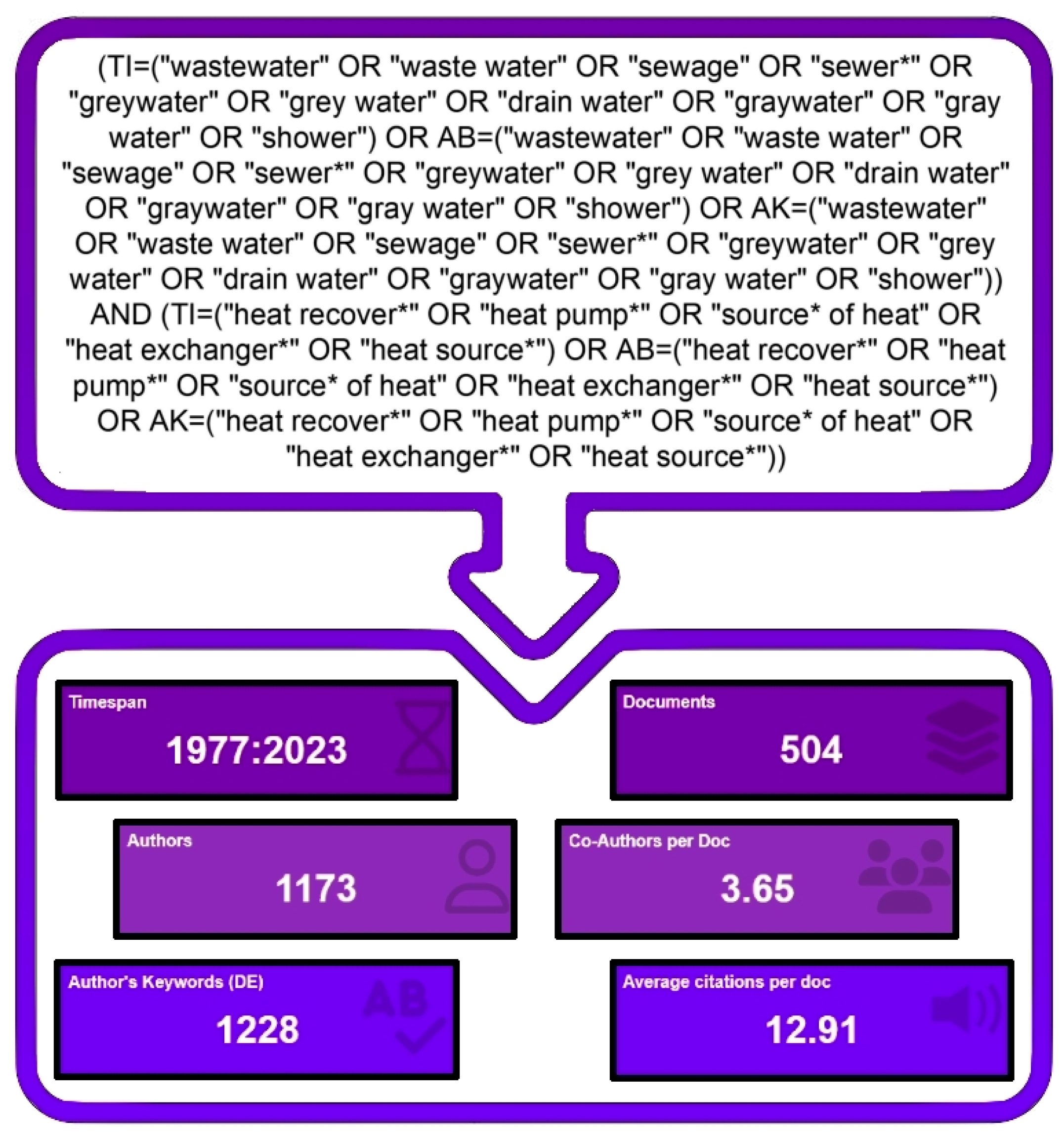
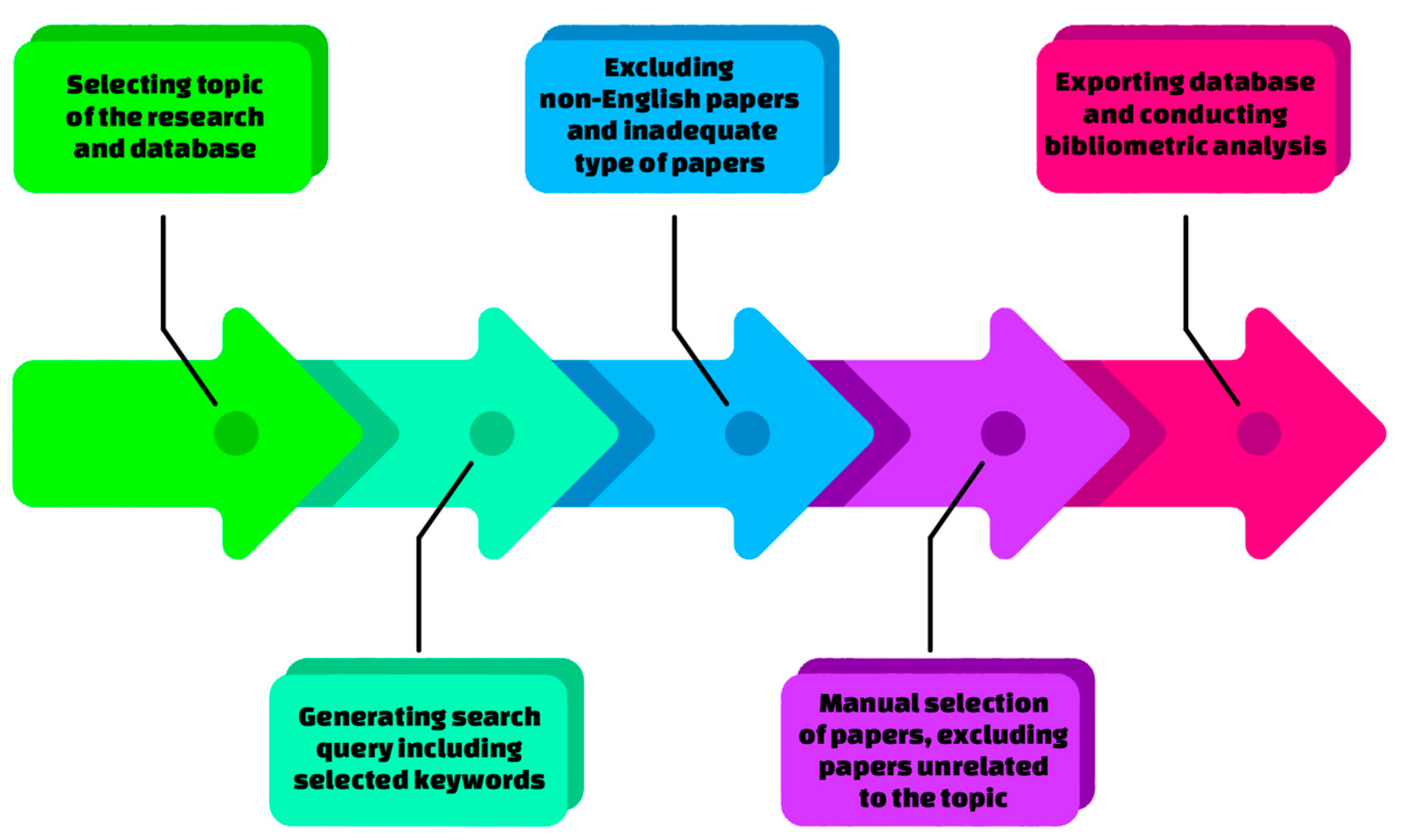


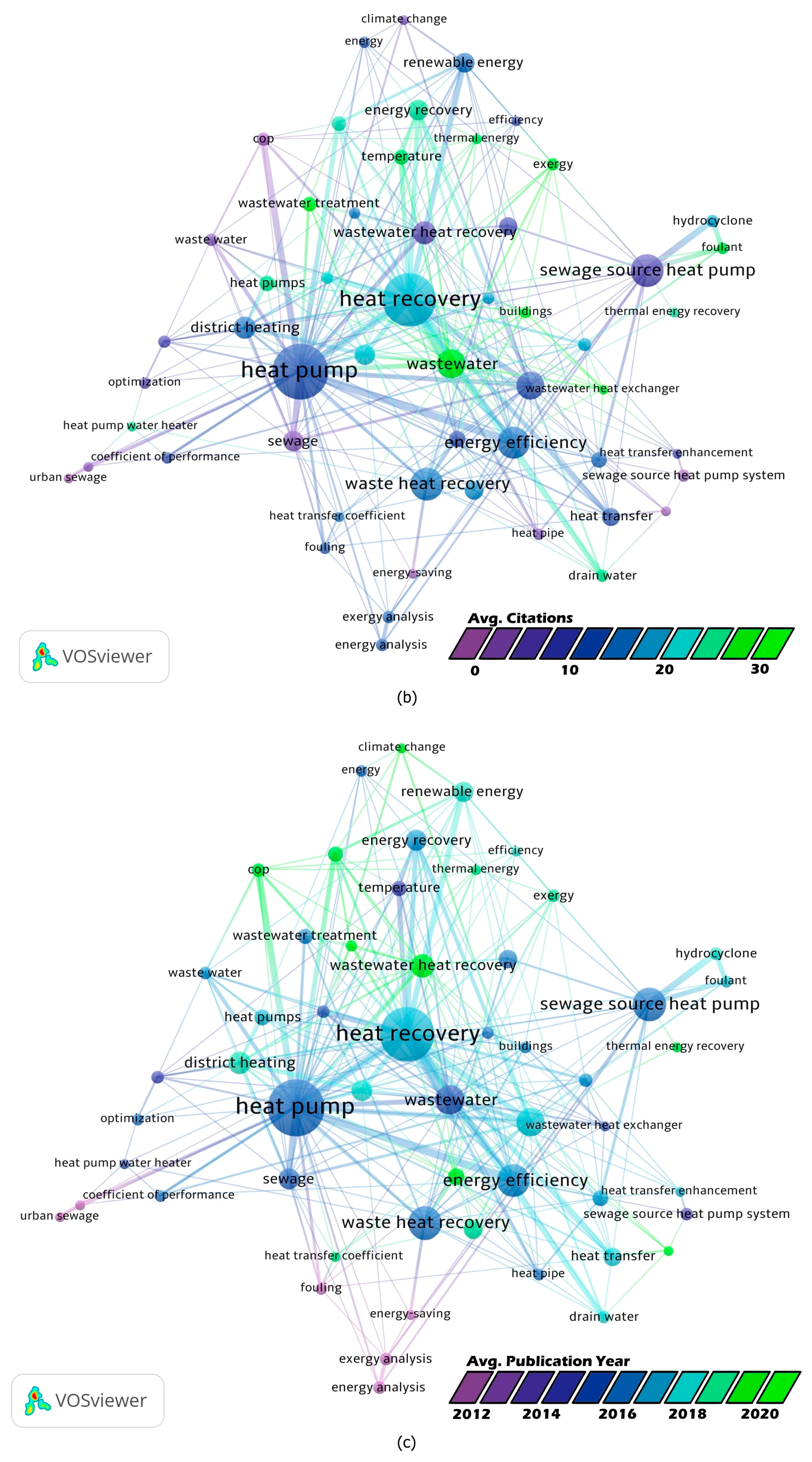
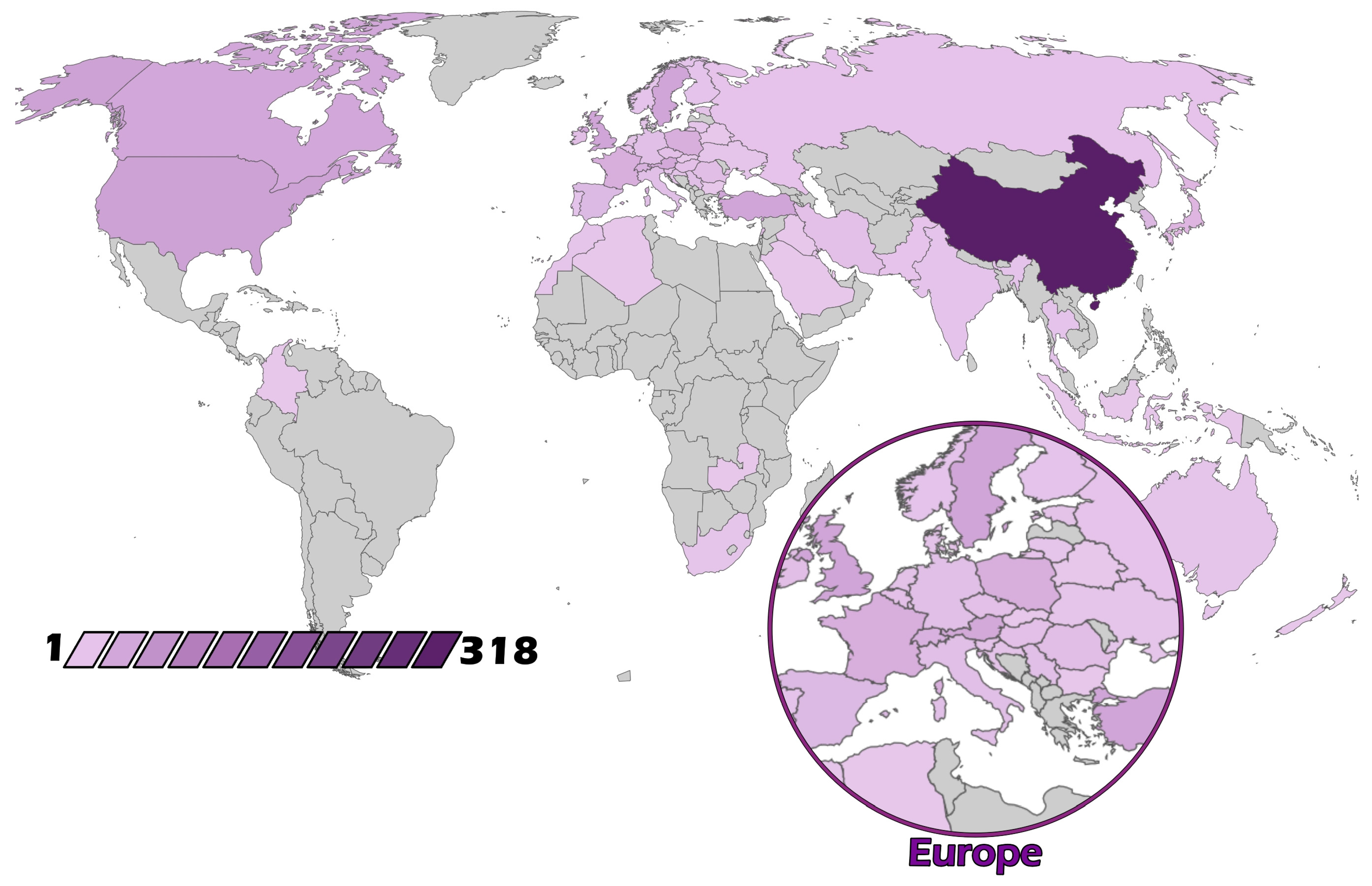
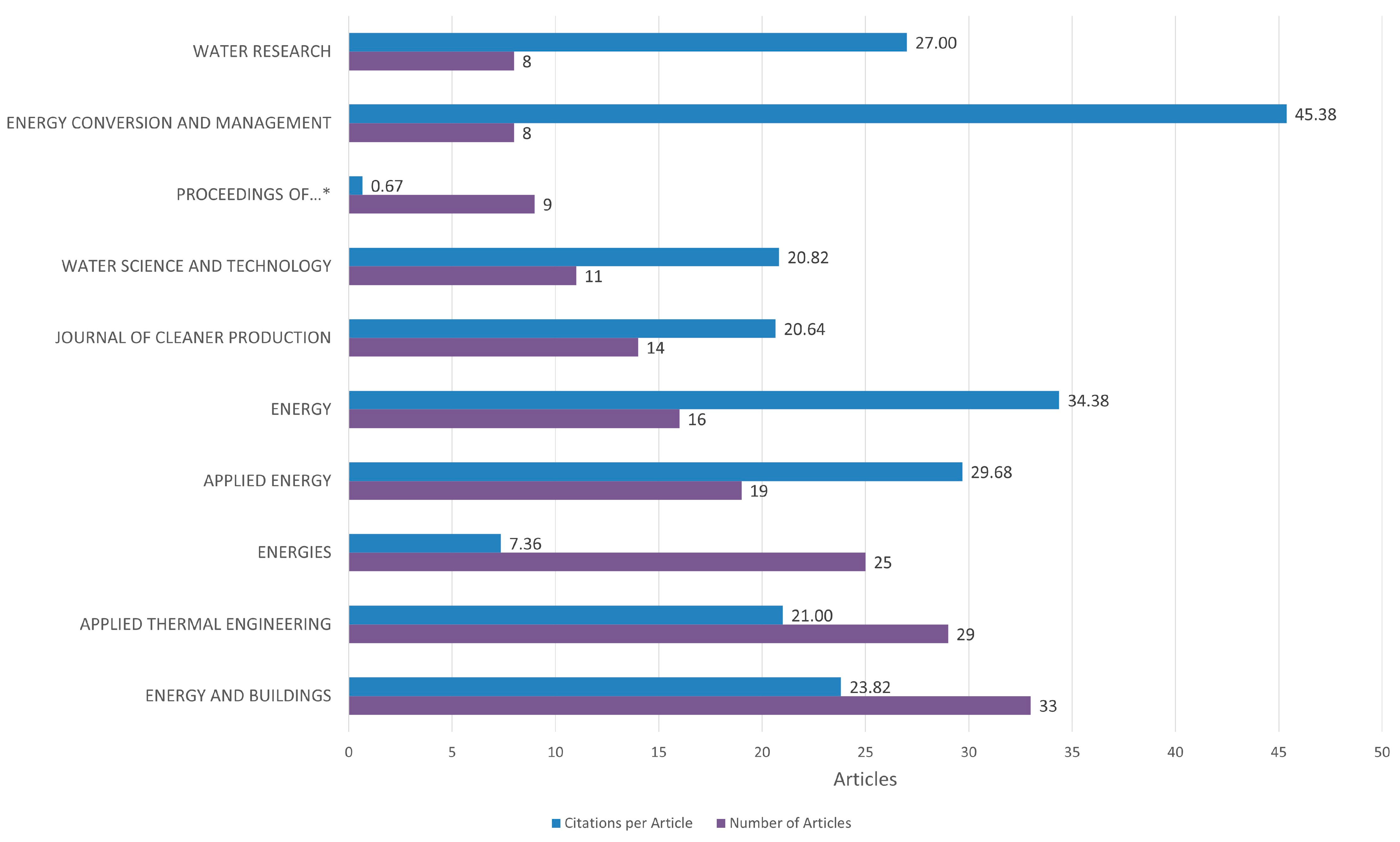
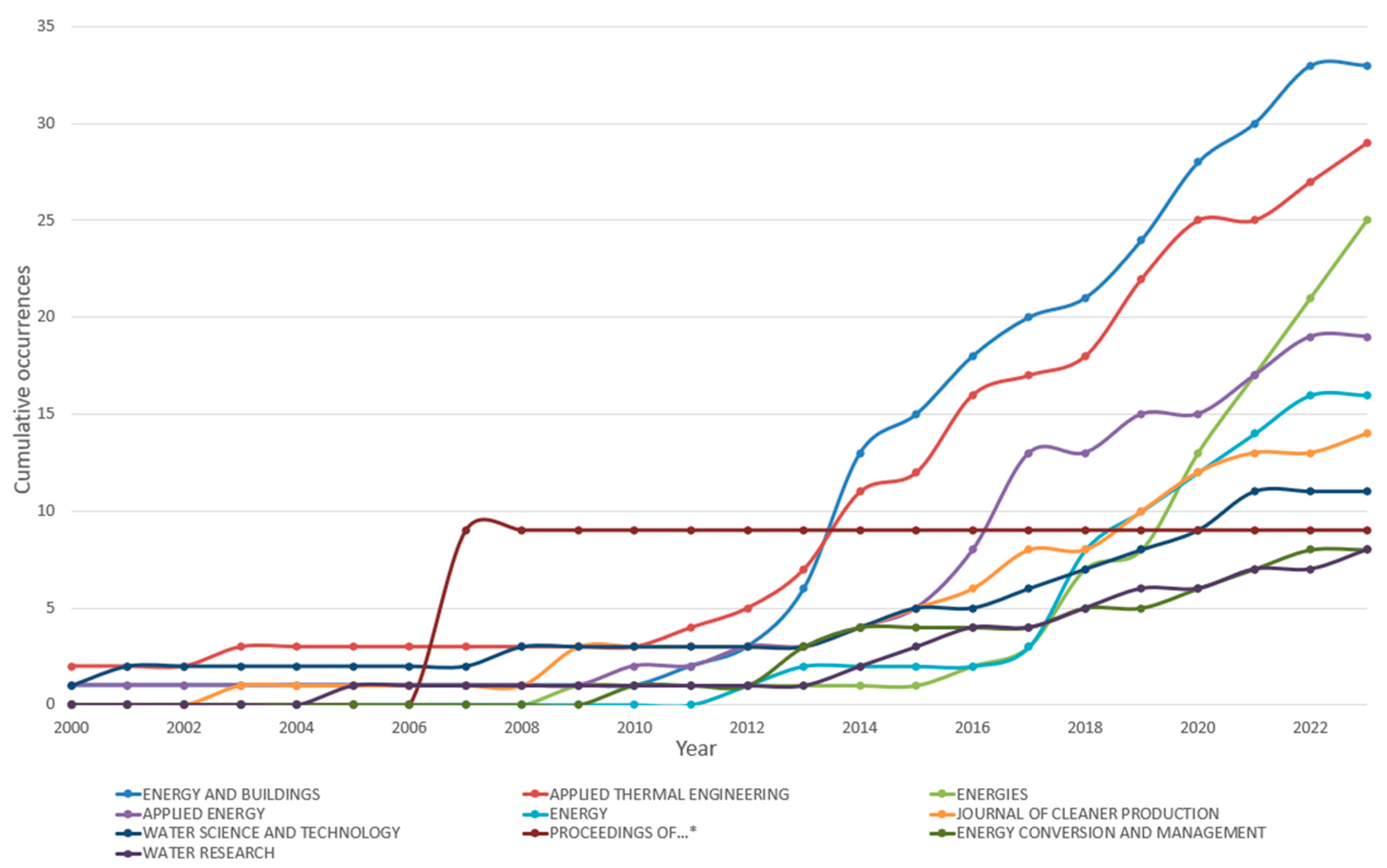
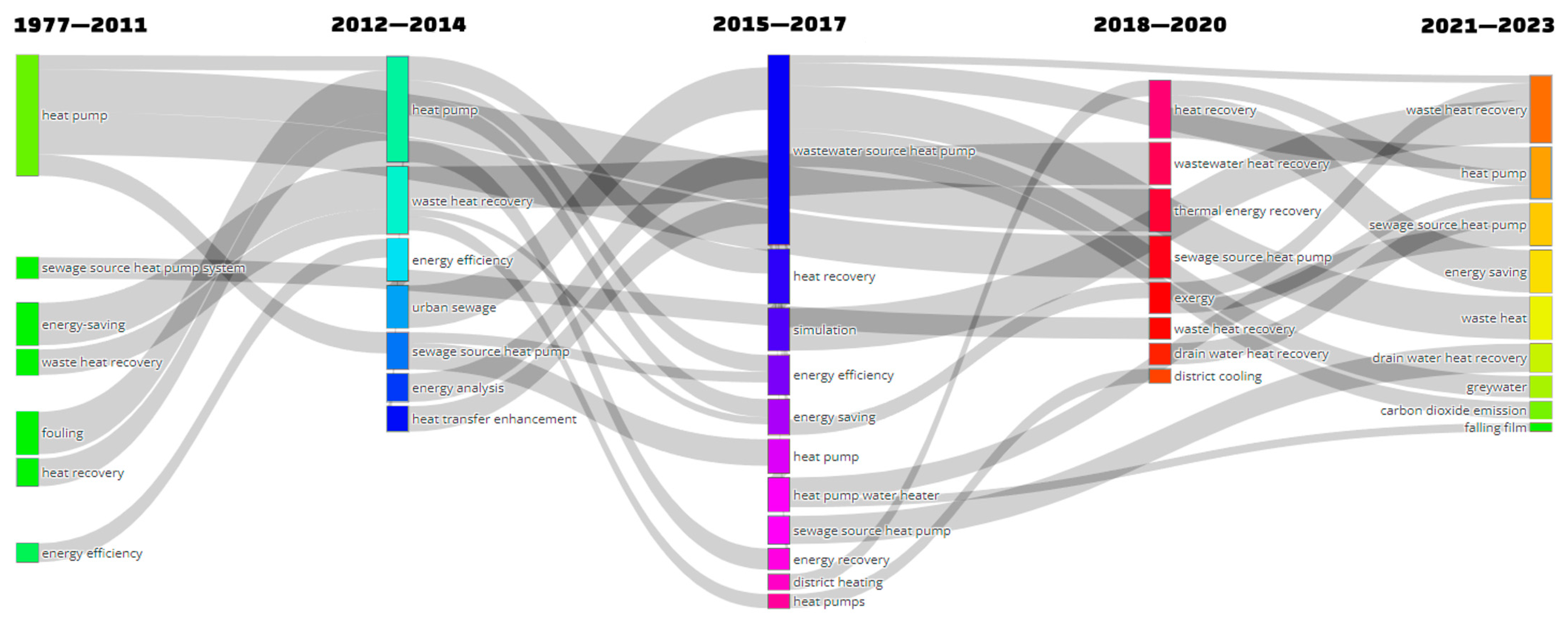
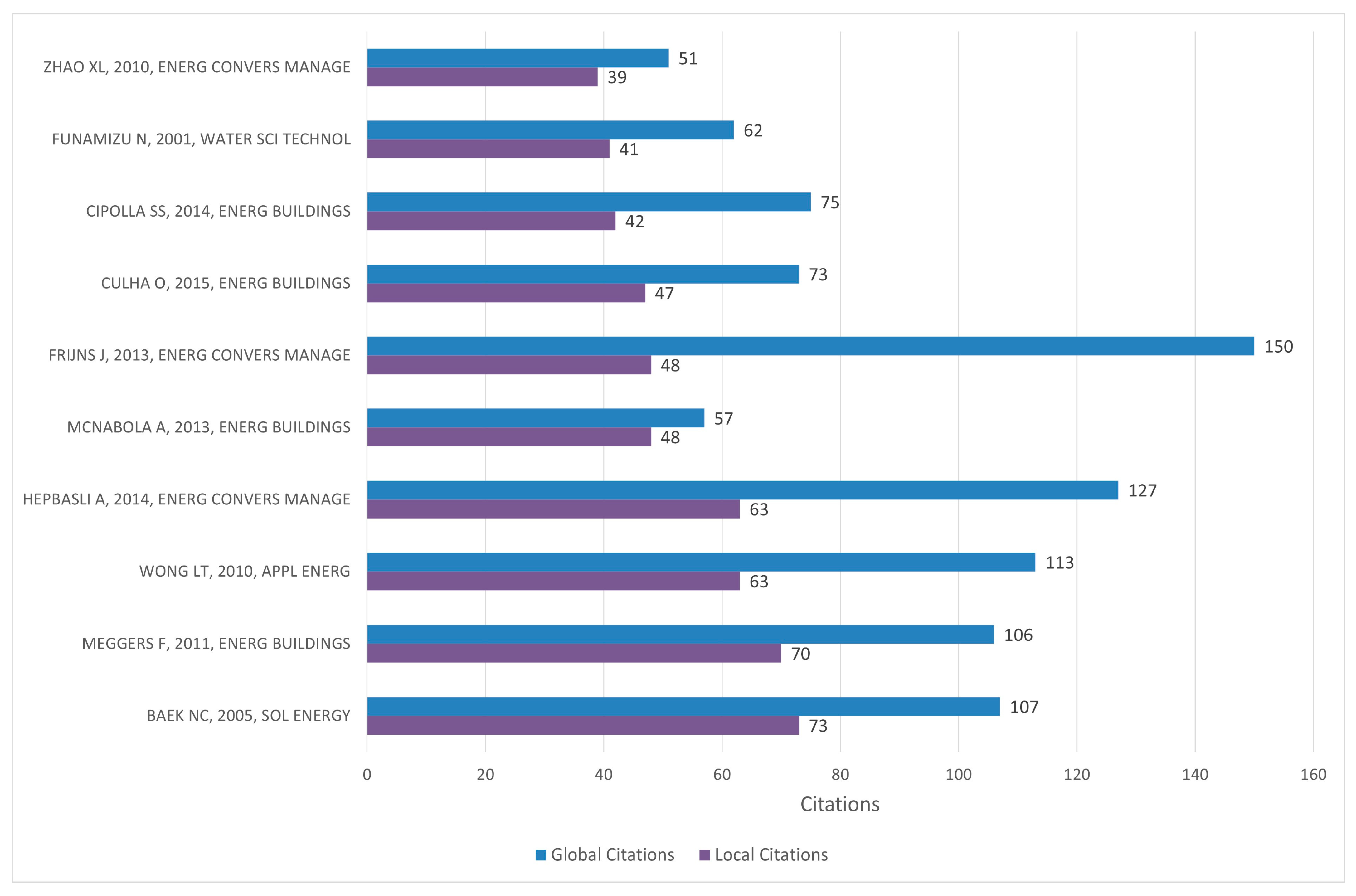
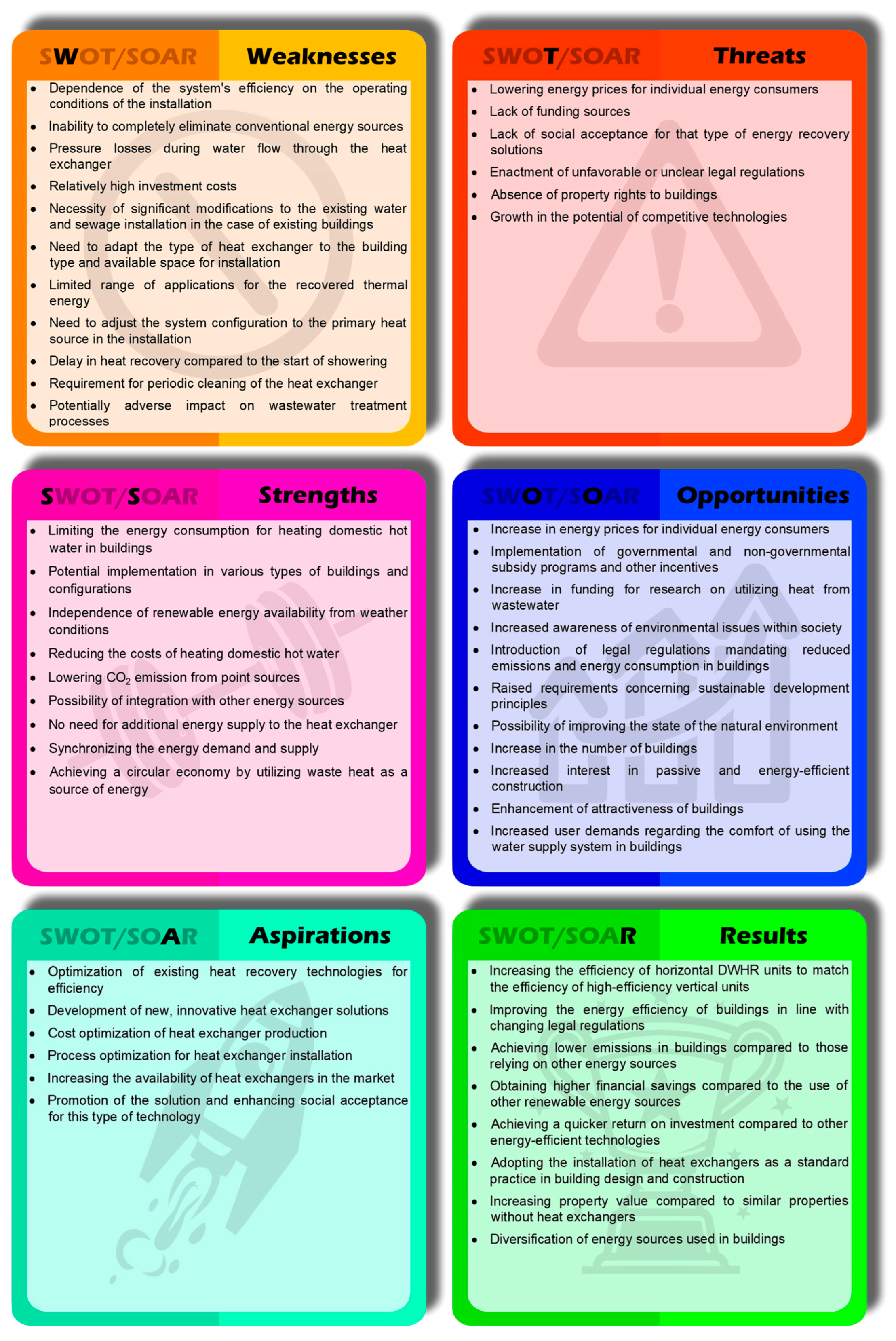
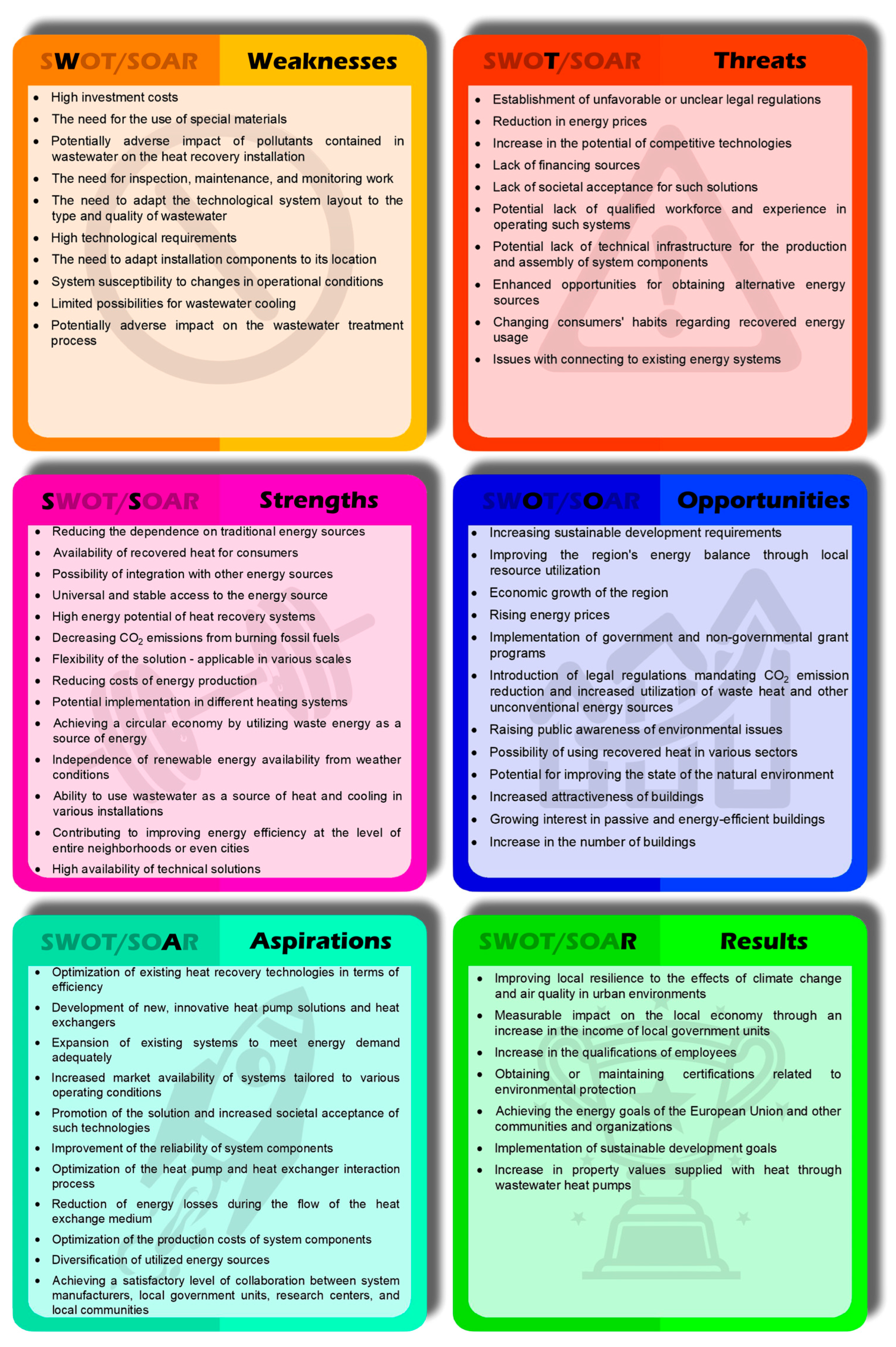
| Authors | Aim of the Paper | Source Title |
|---|---|---|
| Ovadia and Sharqawy [85] | Experimental and analytical analyses aimed at determining the transient characteristics of the vertical drain water heat recovery unit | Case Studies in Thermal Engineering (Elsevier) |
| Singh et al. [86] | Analysis of heat recovery from commercial kitchen grease traps using two different HEs designs | Journal of Cleaner Production (Elsevier) |
| Jadwiszczak and Niemierka [87] | Experimental studies of a horizontal plate heat exchanger with determination of its thermal efficiency and the number of heat transfer units under balanced and unbalanced flow conditions | International Communications in Heat and Mass Transfer (Elsevier) |
| Kordana-Obuch and Starzec [23] | Analysis of the possibility of increasing the efficiency of the horizontal shower heat exchanger by installing baffles | Energies (MDPI) |
| Piotrowska and Słyś [21] | Analysis of the efficiency of the HE in the form of linear drainage with a wavy middle wall | Journal of Building Engineering (Elsevier) |
| Jaleel and Jaffal [88] | Experimental assessment of the influence of the shape of the fins on the efficiency of the phase change material-based HE | Frontiers in Heat and Mass Transfer (Global Digital Central) |
| Schestak et al. [25] | Presentation of a calculator supporting decision-making in the field of heat recovery from drain water in commercial kitchens, considering financial and environmental criteria | Water (MDPI) |
| Ravichandran et al. [75] | Evaluation of the impact of local conditions on the legitimacy of using drain water heat recovery systems and a comparison of these systems with a medium-scale district heating network | Journal of Cleaner Production (Elsevier) |
| Manouchehri and Collins [89] | Presentation of a model for predicting the efficiency of vertical HEs, generated based on experiments on eight units of various lengths and diameters | Resources (MDPI) |
| Selimli et al. [90] | Experimental research on heat recovery from dishwasher greywater | Sustainable Energy Technologies and Assessment (Elsevier) |
| Authors | Aim of the Paper | Source Title |
|---|---|---|
| Seo et al. [32] | The efficiency research of three design variants of a high temperature wastewater heat recovery system in the textile industry, consisting of a heat exchanger and a water tank; the three analyzed configurations of the integrated heat recovery system were developed based on the lower temperature limit of the wastewater | Energies (MDPI) |
| Dimoglo et al. [140] | Research conducted for a pilot installation concerning the reuse of wastewater from industrial laundries, including the analysis of the efficiency of waste heat recovery | International Journal of Environmental Science and Technology (Springer) |
| Lu et al. [153] | Thermodynamic and economic analysis of a high temperature cascade heat pump system using low-temperature wastewater heat to generate steam for industrial processes | Processes (MDPI) |
| Sun et al. [154] | Research on the prototype of a sinusoidal-corrugated plate heat exchanger and thermoelectric modules for heat recovery from industrial wastewater, including comparative analyses of heat exchange efficiency with a plate heat exchanger | Energy Conversion and Management (Elsevier) |
| Kim et al. [151] | Research on the energy efficiency of the heat exchanger network in the heat recovery system from wastewater from the textile industry | Energies (MDPI) |
| Oliveira et al. [155] | Variant analysis of water and energy consumption reduction in a process industry using three different optimization methodologies | Frontiers in Chemical Engineering (Frontiers Media SA) |
| Hu et al. [156] | Research on a new centrifugal heat pump for recovering waste heat from a steel plant for district heating purposes, including environmental and economic analysis of the waste heat recovery system | Energy (Elsevier) |
| Szkarowski et al. [150] | Research on two heat exchangers used for thermal utilization of industrial wastewater generated in the plant for the production of refined fibreboards | Rocznik Ochrona Środowiska (Middle Pomeranian Scientific Society of the Environment Protection) |
| Maddah et al. [157] | Comparative analysis of energy, exergy, economic, and environmental aspects of an industrial wastewater heat pump with an air-source heat pump and a geothermal heat pump | Journal of Cleaner Production (Elsevier) |
| Yang et al. [158] | Research on the Organic Rankine Cycle system using an evaporative condenser to recover heat from wastewater in the petrochemical industry | Energy Conversion and Management (Elsevier) |
| Etemoglu [152] | Analysis of the efficiency of industrial combined heat and power generation systems based on waste heat including the analysis of the selection of the working fluid | International Communications in Heat and Mass Transfer (Elsevier) |
Disclaimer/Publisher’s Note: The statements, opinions and data contained in all publications are solely those of the individual author(s) and contributor(s) and not of MDPI and/or the editor(s). MDPI and/or the editor(s) disclaim responsibility for any injury to people or property resulting from any ideas, methods, instructions or products referred to in the content. |
© 2023 by the authors. Licensee MDPI, Basel, Switzerland. This article is an open access article distributed under the terms and conditions of the Creative Commons Attribution (CC BY) license (https://creativecommons.org/licenses/by/4.0/).
Share and Cite
Kordana-Obuch, S.; Wojtoń, M.; Starzec, M.; Piotrowska, B. Opportunities and Challenges for Research on Heat Recovery from Wastewater: Bibliometric and Strategic Analyses. Energies 2023, 16, 6370. https://doi.org/10.3390/en16176370
Kordana-Obuch S, Wojtoń M, Starzec M, Piotrowska B. Opportunities and Challenges for Research on Heat Recovery from Wastewater: Bibliometric and Strategic Analyses. Energies. 2023; 16(17):6370. https://doi.org/10.3390/en16176370
Chicago/Turabian StyleKordana-Obuch, Sabina, Michał Wojtoń, Mariusz Starzec, and Beata Piotrowska. 2023. "Opportunities and Challenges for Research on Heat Recovery from Wastewater: Bibliometric and Strategic Analyses" Energies 16, no. 17: 6370. https://doi.org/10.3390/en16176370
APA StyleKordana-Obuch, S., Wojtoń, M., Starzec, M., & Piotrowska, B. (2023). Opportunities and Challenges for Research on Heat Recovery from Wastewater: Bibliometric and Strategic Analyses. Energies, 16(17), 6370. https://doi.org/10.3390/en16176370








